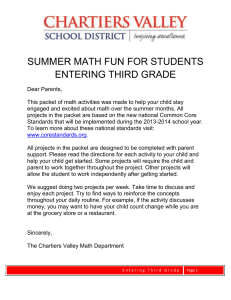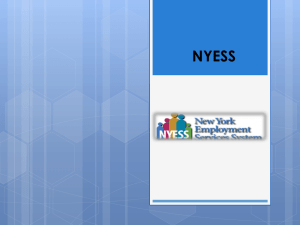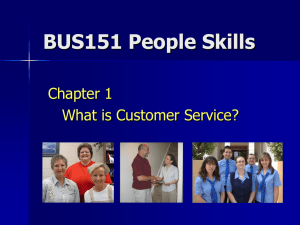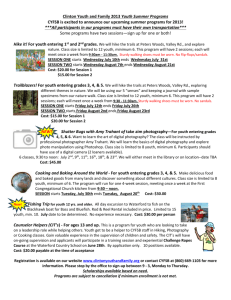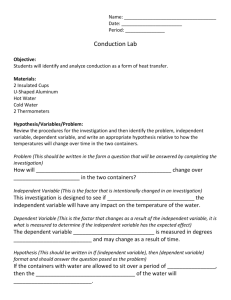Answer Key- Math Fun- Entering 3rd Grade
advertisement
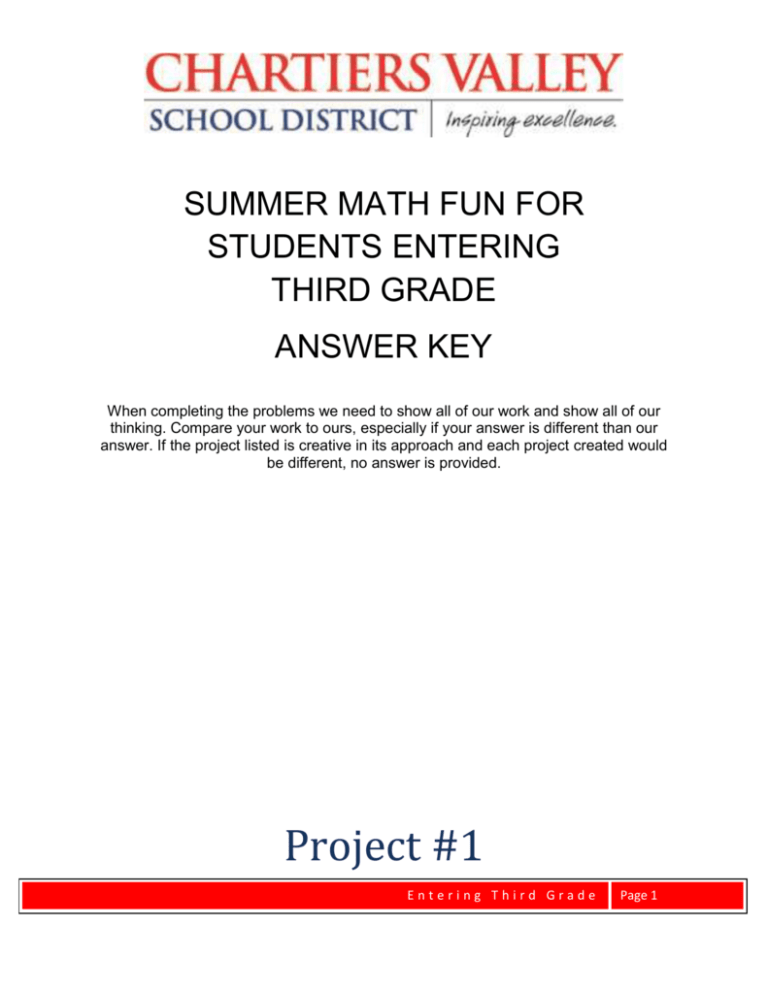
SUMMER MATH FUN FOR STUDENTS ENTERING THIRD GRADE ANSWER KEY When completing the problems we need to show all of our work and show all of our thinking. Compare your work to ours, especially if your answer is different than our answer. If the project listed is creative in its approach and each project created would be different, no answer is provided. Project #1 Entering Third Grade Page 1 Domain: Number and Operations in Base Ten (NBT) Learning Targets: I can read and write numbers up to 1000. I can explain the process for determining whether a three-digit number is greater than, less than or equal to another three-digit number. Directions: Cut out the number cards below. Then follow the directions to complete the activity with the cards and record your answers. Example: Build the largest number you can. Record it here: 9,876,543,210 2. Build the smallest number you can. Record it here: _________________ 3. Build a number less than 700. Record it here: _________________ 4. Build a number greater than 700. Record it here: _________________ 5. Build a number that is between 300 and 500. Record it here: _________________ 6. Build a different number that is between 300 and 500. Record it here: _________________ Entering Third Grade Page 2 Project #2 Domain: Operations and Algebraic Thinking (OA) Learning Targets: I can choose when to use addition and/or subtraction in a word problem. I can represent addition and subtraction word problems using objects, drawings, and equations with unknowns in all positions. I can solve addition and subtraction word problems that involve two-steps. Directions: Solve the following word problem. Amy had 62 hair clips in her collection. She bought a pack of 36 hair clips to add to her collection. How many does she have now? Write a number sentence below to solve the problem. 62 + 36 = 98 hair clips In the space below write your own word problem using 2 or 3 digit numbers. Solve the problem below using a number sentence. . Entering Third Grade Page 3 Project #3 Domain: Number and Operations in Base Ten (NBT) Learning Targets: I can represent a hundred as ten groups of ten. I can represent each digit in a three digit number using hundreds, tens and ones. I can explain the value of each digit in a three-digit number. I can explain the value of the zeros in a given hundred as zero tens and zero ones. Directions: In the United States we express numbers in a certain way. The ancient Egyptians expressed numbers differently. Use the key to write numbers in Egyptian hieroglyphics. Examples: For Ancient Egyptians the number 36 would be The number 111 would be Try to write the number 3 using Egyptian hieroglyphics Try to write the number 47 using Egyptian hieroglyphics Try to write the number 101 using Egyptian hieroglyphics Entering Third Grade Page 4 Project #4 Domain: Operations & Algebraic Thinking (OA) Learning Targets: I can identify a group of objects as being even or odd using different strategies. I can write an equation to show an even sum has the same addends. Directions: Show a given number using the model below. Then, label the number as “odd” or “even”. The number is odd if there is one left over without a partner. The number is even if there is none left over. Example: Entering Third Grade Page 5 Project #5 Domain: Measurement and Data (MD) Learning Targets: I can select an appropriate tool (ruler, yardstick, meter stick, measuring tape) to measure an object. I can measure the length of an object using a tool. Directions: Use a one-foot ruler to measure different objects in your home. Write the measurements of the objects in the chart below. Entering Third Grade Page 6 Project #6 Domain: Measurement and Data (MD) Learning Targets: I can add and subtract lengths of the same unit within 100. I can represent addition and subtraction word problems involving lengths of the same unit by using drawings and equations with a symbol for the unknown length. I can solve for the unknown number in an equation from a word problem. Directions: Answer the questions below. Entering Third Grade Page 7 Project #7 Domain: Number and Operations in Base Ten (NBT) Learning Targets: I can add and subtract numbers within 100 with ease by applying strategies (decomposing numbers into tens and ones, using commutative and associative properties, using mental strategies) based on the numbers being added or subtracted. Entering Third Grade Page 8 Directions: Estimate the answer to the addition problems below. Round the numbers in the addition problems below to help you estimate an answer. When adding two numbers of 2 or 3 digits, first round to the nearest ten and then add both numbers. Example: When adding: 73 + 59 = To estimate a solution first round each number to the nearest ten: 70 + 60 = Then, add the numbers. 70 + 60 = 130 Estimate the answers to the problems below: 1) 89 + 64 = 90 + 60 = 150 2) 51 + 33 = 50 + 30 = 80 3) 28 + 21 = 30 + 20 = 50 4) 19 + 11 = 20 + 10 = 30 5) 121 + 61 = 120 + 60 = 180 Project #8 Domain: Number and Operations in Base Ten (NBT) Learning Targets: I can choose when to use addition and/or subtraction in a word problem. I can represent addition and subtraction word problems using objects, drawings, and equations with unknowns in all positions. I can solve addition and subtraction word problems that involve two-steps. I can use mental strategies to add or subtract numbers within 20 with Entering Third Grade Page 9 ease. I can recall from memory all sums of two one-digit numbers. Directions: Find the rule for all of the problems below. Follow the example below. Project #9 Domain: Measurement and Data (MD) Learning Targets: I can create a number line with whole number intervals (equal spacing). I can represent whole numbers on a number line. Entering Third Grade Page 10 I can find sums and differences within 100 using a number line. Directions: Show the addition and subtraction problems on the number lines below. Example: 17-3=14 I put a star at 17 to start. Then, I hopped back 3 to 14. 17-3= 14. 15 – 5 = 9+4= Project #10 Domain: Geometry (G) Learning Targets: I can identify the defining attributes of a shape. Entering Third Grade Page 11 I can use defining attributes to name shapes. Directions: Trace all the shapes in the picture below with a colored pencil or marker. List the different shapes you have found below: Square, Rectangle, Circle, Oval, Cube, Trapezoid,Triangle Project #11 Domain: Number and Operations in Base Ten (NBT) Entering Third Grade Page 12 Learning Targets: I can skip count to 1000 by 5’s, 10’s and 100’s Directions: Cut out the number cards below. Next, put the cards in numerical order. Then, practice counting by 100s to 1000. Project #12 Domain: Measurement and Data (MD) Entering Third Grade Page 13 Learning Targets: I can make a picture or bar graph with up to four categories to represent data. I can compare data on a bar graph. I can solve addition and subtraction problems using data from a picture or bar graph. Directions: Collect the following items: clock or watch blank paper graph paper (can be hand-drawn) ruler markers Together with your child, keep track of how he or she spends time in one 24-hour period: time spent sleeping, eating, playing, reading, and going to school. Measure a strip of paper that is 24 inches long. Let each inch represent 1 hour. Color in the number of hours for each activity, using a different color for each activity. When finished, make the strip into a circle and place it on a blank piece of paper. Trace around the circle. Then make lines from the center of the circle to the end of each color. Your child has just made a circle (pie) chart of how he or she spends 24 hours. Compare this with how other people in your family spend their time. Entering Third Grade Page 14 Project #13 Domain: Operations and Algebraic Thinking (OA) Learning Targets: I can identify a group of objects as being even or odd using different strategies. I can write an equation to show an even sum has the same addends. Directions: Sort the even and odd numbers listed below into the table below. Write the even numbers in the even category and the odd numbers in the odd category. After you are finished sorting the numbers explain to an adult why certain numbers are odd and certain numbers are even. Entering Third Grade Page 15 Project #14 Domain: Measurement and Data (MD) Learning Targets: I can identify and give the value of dollar bills, quarters, dimes, nickels, and pennies. I can use $ (dollar) and ₵ (cents) symbols appropriately. I can solve a word problem with dollar bills, quarters, dimes, nickels, and pennies. Directions: Find one penny, one nickel, one dime, and one quarter. Order the value from least to greatest. Answer the following questions: 1. Which coin is worth the least amount? How much is it worth? Penny, 1 cent 2. Which coin is worth the most? How much is it worth? Quarter, 25 cents 3. If you had to make 31 cents to pay for something, which coins would you use? More than one answer: One quarter, one nickel, one penny 3 dimes, one penny 6 nickels, one penny Entering Third Grade Page 16 Project #15 Domain: Geometry (G) Learning Targets: I can divide a circle and rectangle into two, three or four equal parts. I can describe the equal share with words (halves, thirds, fourths). I can describe a whole by the number of equal parts (eg. two halves make a whole). I can explain and give examples to show that halves, thirds, and fourths of an identical whole need not be the same shape (eg. half of a rectangle can be shown vertically or horizontally). Directions: Collect the following supplies: clear container masking tape marker measuring cups ( 1/2, 1/3, or 1/4 cup measure) uncooked rice or popcorn kernels water 1. Have your child stick a piece of masking tape straight up one side of the clear container from the bottom to the top. 2. For younger children, use a 1/2 cup measure. For older children, use a 1/3 or 1/4 cup measure. Choose the unit of measure and fill the measuring cup. Then let your child pour the substance from the measuring cup into the clear container. Continue to pour the same amount of the substance into the container. 3. As each equal amount of the substance is poured, mark the level on the container by drawing a line on the tape. Write the cup size or appropriate fraction on each line. The fraction for onethird cup would be 1/3. 4. Follow this procedure until the container is full and the tape is marked in increments to the top of the container. 5. Fill the container again and again using different measures each time. Ask your child "thinking" questions. How many whole cups do you think this container will hold? How many 1/2 cups, 1/3 cups, or 1/4 cups do you think the container will hold? Entering Third Grade Page 17 How many 1/2 cups equal a cup? How many 1/4 cups equal 1/2 cup? A cup? How many 1/4 cups equal 3/4 cup? Project #16 Domain: Operations and Algebraic Thinking (OA) Learning Targets: I can use mental strategies to add or subtract numbers within 20 with ease. I can recall from memory all sums of two one-digit numbers. Directions: Collect the following items: Deck of cards Kitchen timer 1. Shuffle the deck of cards and deal them face down, giving each player an equal number of cards until the deck runs out. Each player keeps his cards in a stack. Assign picture cards, such as jacks, queens, and kings, a value of 10. Give aces a value of 1. 2. Demonstrate to your child how to play the game: Each player turns two cards face up, reads the number sentence and gives the answer. For example, if your child draws a 5 and a 4, he says 5 -4 = 1. If you draw a 7 and an 2, then your number sentence is 7-2 = 5. Because your result is larger, you win the four cards and you put them at the bottom of your pile. 3. If each of you has a number sentence with the same answer, then it's war! At this point, you'll reverse the math "operation" and do an addition problem. Each player puts four cards face down and turns up two of them. The player with the highest sum wins all eight cards. 4. Set up the timer and play the game for 10 to 15 minutes. When the bell goes off, each player counts his cards. The player with the most cards wins. If one player runs out of cards before time is up, then the other player wins. Entering Third Grade Page 18 Project #17 Domain: Measurement and Data (MD) Learning Targets: I can identify and give the value of dollar bills, quarters, dimes, nickels, and pennies. I can use $ (dollar) and ₵ (cents) symbols appropriately. I can solve a word problem with dollar bills, quarters, dimes, nickels, and pennies. Directions: Pick two items to buy from the menu below. Then, add up the total cost of your food. Next, write a sentence and draw a picture of the types of bills and coins you would give to the cashier to pay for your food. Entering Third Grade Page 19 Project #18 Domain: Measurement and Data (MD) Learning Targets: I can explain the difference between a.m. and p.m. I can look at the time on an analog clock (when the hour hand is pointing to any of the numbers 1-12), say what time it is, and write the time as it would appear on a digital clock. I can look at the time on a digital clock (when the minutes are a multiple of 5), say what time it is, and draw in the hands on an analog clock. I can write the time and draw in the hands on an analog clock when Entering Third Grade Page 20 someone tells me what time it is to the nearest 5 minutes. I can understand special terms such as: half past, quarter after, quarter to ___ minutes after, ___minutes to. Directions: Create a chart of your favorite times of day. Include a.m. and p.m. in your chart. Extensions The following activities are based on standards your child will learn in third or fourth grade. They may be challenging for your child. Project #19 Entering Third Grade Page 21 Domain: Measurement and Data (MD) Learning Targets: I can estimate and measure liquid volumes and masses of objects using standard units of measure. Directions: Draw a line from the unit word to the system you measure it with. For example, you could draw a line from the picture of a ruler to the word inches. Project #20 Domain: Geometry (G) Learning Targets: I can identify line-symmetric figures. I can define line of symmetry, explain how to identify it in a twoEntering Third Grade Page 22 dimensional figure, and explain how folding along the line of symmetry results in matching parts. I can draw a line on a figure to create two symmetric figures. Directions: In which figure below is a line of symmetry shown? How do you know? Explain your answers in 3-4 complete sentences. If needed, cut out the pentagon on the bottom of the page and fold it in various ways to find the lines of symmetry. Correct Answer is D Helpful Websites Visit one of the websites below and learn about one of the games. Play the game together for 10-20 minutes. Give your child time to play the game independently. Then, check to ensure your child is playing the game correctly and has mastered the concept. Entering Third Grade Page 23 Penguin Addition allows student to add one-digit number at various speeds. http://www.sheppardsoftware.com/mathgames/popup/popup_addition.htm Or, play the addition farm game that allows you to choose different addition fact families to practice: http://www.fun4thebrain.com/addition/ffoadd.html Entering Third Grade Page 24
